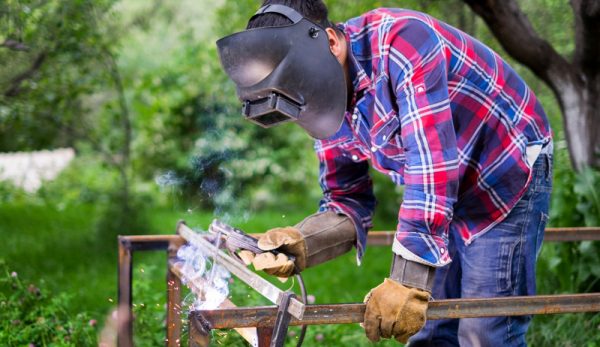
In your time on the farm or the homestead, you’ve almost certainly broken some metal part that you haven’t been able to do much about.
Maybe you paid someone more than you would have liked to repair it. Or maybe the piece still needs to be fixed.
When you learn how to weld, you can start fixing your own machinery, and even custom fabricate equipment that you need around the farm.
Types of Welding
Without getting too far into the science (and there is a lot of science), welding is a process of joining two pieces of metal together using heat, frequently in the form of electricity.
There are a variety of different ways to fuse metal together. And each of the commonly used welding processes have their own benefits and drawbacks.
Read more: Check out out buyer’s guide for farmer in search of a welder!
Stick Welding
For repairs around the farm, most people prefer stick welding. It’s true that other welding processes can give cleaner and sometimes stronger welds. But stick welding can allow you to join together relatively dirty or rusty surfaces.
Think repairing a rusty gate that someone backed a trailer into.
Stick welding can also work on a variety of different metals–including iron, steel and aluminum–making it a versatile option around the farm.
Metal Inert Gas
If you anticipate doing a lot of fabrication, on the other hand, MIG (metal inert gas) welding might be a better fit. Unlike stick welding, MIG uses a “shielding gas” to protect the weld from contamination. This creates a generally cleaner and stronger weld.
Maybe, for instance, your farm truck needs a new roof rack to transport lengths of lumber or pipe around the property.
Learning multiple welding processes doesn’t necessarily mean that you have to purchase multiple welders. Some welders are “multi-process,” meaning that they will allow you to switch back and forth between various welding processes, including stick and MIG.
Select a Process
Begin by figuring out what kind of metalwork you anticipate needing to do around your farm.
Are you frequently breaking tractor implements, trailer hitches or gates? If so, leaning to stick weld would probably be the way to go.
Maybe, on the other hand you’ve always had ideas about how to modify or fabricate machinery but have never had a way to do so. If so, MIG might be a better match.
Read more: What’s the best way to approach spring fence repair?
Basic Equipment
Once you’ve decided on a process, it’s time to buy the equipment and materials you’ll need.
Used welders (especially stick welders) pop up on Craigslist all the time, so make sure to look around for used options. Depending on the kind of welder you buy, you may need to purchase some gas canisters, electrodes or spools of wire to get your welder running.
Given the dangers of welding, it’s important to use safety equipment whenever you’re working. Invest in a good welding helmet, ear protection, fire-resistant clothing and heavy-duty welding gloves.
Given the kinds of metals you plan on welding, you may need to use a respirator as well.
Finally, you’ll need an angle grinder to cut and clean metal, some clamps to hold your projects in place and a welding hammer to chip away the slag from your welds.
Getting Started
Ready to learn how to weld?
Like any new skill, welding takes time to master. The best way to learn how to weld is with a friend or mentor who has been doing it for a while.
But, you can also teach yourself. Youtube is filled with helpful welding tutorials and there are numerous free resources online.
Find some scrap metal around the farm or from the local junk yard and start experimenting in your shop. You’ll have a lot of fun learning, and before you know it will be able to maintain your own machinery in a whole new way.




